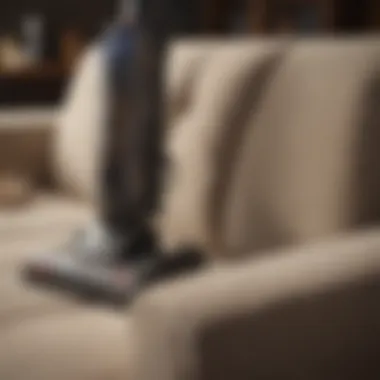How to Make Your Couch Smell Fresh and Inviting


Intro
Living with pets enriches our lives but often brings challenges, especially when it comes to maintaining a clean and pleasant-smelling home. A couch, central to most living spaces, can quickly become a reservoir for odors if not properly cared for. In this guide, we will explore effective methods to ensure your couch smells good, emphasizing strategies particularly relevant for pet owners. From cleaning techniques to the use of natural deodorizers, this comprehensive approach aims to elevate your household environment amidst the reality of sharing space with animals.
Pet Care and Grooming
Importance of Regular Care
For pet owners, maintaining a clean couch goes hand in hand with regular pet grooming. Grooming your pet can significantly reduce the amount of hair and dander that finds its way onto upholstery. Regular brushing, bathing, and nail trimming keep your pet's coat healthy while minimizing odors.
Grooming Techniques by Pet Type
Different pets require unique grooming approaches. For example, long-haired cats and dogs need frequent brushing to avoid matting and reduce shedding. On the other hand, short-haired breeds generally require less attention. Here are a few techniques:
- For Dogs: Regularly brush your dog's coat based on the breed's specific needs. Utilize de-shedding tools or grooming gloves.
- For Cats: Frequent brushing can help manage hairballs and reduce shedding. Consider cat-specific brushes that are gentle on their skin.
Tools and Products Recommendations
Having the right tools can make a difference in your grooming routine. Consider investing in:
- High-quality brushes suited to your pet's coat type.
- Pet-safe shampoos for cleaning.
- Odor-neutralizing sprays designed for upholstery.
Seasonal Care Tips
Different times of the year may prompt specific grooming needs. During spring, most pets shed their winter coats, which means more frequent grooming. In the fall, pets may shed less but require a check-up for potential dry skin as indoor heating is turned on.
Quality pet care is key to maintaining a fresh-smelling home.
Health and Nutrition
Understanding Pet Nutrition
A well-balanced diet plays a crucial role in your pet's health. A poor diet can lead to skin issues and odors that might cling to your couch. It is essential to choose high-quality pet foods that cater to your pet's specific dietary needs.
Common Health Issues by Species
Pet owners should be aware of health problems that may contribute to odors. For instance, dental issues in dogs can lead to bad breath, while skin infections in cats may cause offensive smells. Regular check-ups with a veterinarian can help catch these problems early.
Preventive Care and Regular Check-Ups
Regular veterinary visits are vital for ensuring your pet remains healthy. This practice can prevent potential health issues and manage existing conditions, substantially reducing odor sources in your home.
Food and Dietary Advice
Consider dietary adjustments based on age, weight, and activity levels. A proper diet can help maintain a good coat and healthy skin, essential for minimizing unpleasant scents around your couch.
Behavioral Training
Basics of Positive Reinforcement
Effective training can reduce accidents that lead to odors on your couch. Utilize positive reinforcement to teach desired behaviors, guiding your pet to avoid the furniture altogether.
Training Techniques Users Can Apply
Incorporating basic commands can help keep your furniture safe. Use techniques like:
- Consistent commands like
Understanding Odors: Sources and Causes


Understanding the sources and causes of odors is crucial for pet owners who wish to maintain a pleasant living environment. Embracing this knowledge not only aids in identifying problem areas but also fosters an awareness of how certain odors can develop over time. Several factors contribute to couch odors, from pet-related substances to everyday wear and tear. By recognizing these influences, owners can better devise strategies to combat unwanted scents effectively.
Types of Odors That Can Accumulate
Odors that accumulate in upholstery commonly stem from a variety of sources. Pet dander, urine, and fur are prominent contributors. Additionally, everyday activity like eating or drinking on the couch can lead to food and drink spills, which leave behind persistent smells. Other aspects include:
- Bacteria Growth: Moisture can create an environment for bacteria to thrive, generating unpleasant odors.
- Grease and Oils: Natural oils from skin, combined with food residues, can create a sour smell.
- Environmental Factors: Dust, smoke, and other particles can settle into fabric, contributing to stale odors.
These types of odors often intersect. For instance, pet fur can trap bacteria and moisture, combining several sources into one foul scent.
Impact of Pets on Upholstery Scent
Pets profoundly influence the scent of upholstery in any home. Their natural behaviors lead to smells that become embedded in furniture. For instance, dogs and cats shed fur, which can carry odors from outside, their diet, or even from the litter box. This accumulation can embed deeply into couch fabric.
Consider the following:
- Fleas and Ticks: Parasitic infestations can result in an unpleasant musty or earthy scent, affecting fabric.
- Waste Accidents: Unattended mishaps can lead to particularly potent smells if not dealt with immediately.
- Pheromones: Some animals have scent markers, which can contribute to distinctive smells unique to their presence.
The higher the frequency of pet interaction on the couch, the more intense these fragrances can become. Therefore, understanding the impact of pets is essential for tackling stubborn odors and maintaining a fresh-smelling upholstery.
Initial Assessment of the Couch
An initial assessment of your couch is critical in maintaining a pleasant living environment, especially for pet owners. Understanding the condition of your upholstery allows you to pinpoint the areas where odors may have developed. This step ensures that you are not just covering smells but are addressing the root cause. A thorough assessment sets the stage for a more effective cleaning strategy, which can enhance your couch's longevity as well.
Identifying Problem Areas
Start by examining the surface of your couch. Look for any visible stains, spots, or discoloration that could harbor odors. Pay special attention to seams and crevices, where pet hair or debris often collects. You may want to use a flashlight to illuminate darker areas. Consider the following:
- Scrutiny: Take close looks at cushions and under them. Lift them to inspect for hidden dirt.
- Smell Test: Bring your nose closer to different areas. This can help identify specific spots emitting unfavorable scents.
- Surface Texture: Notice any sticky or damp spots. Such areas may indicate moisture build-up, which can cause mold or mildew.
By pinpointing these problem areas, you can prepare for more targeted cleaning efforts.
Assessing Fabric Type for Cleaning Methods
Different fabrics require distinct care approaches. Knowing your couch’s fabric type will inform you which cleaning methods are suitable. Here are a few common types:
- Microfiber: This material is generally durable and can withstand occasional scrubbing. You should avoid excess water to prevent stains.
- Leather: Leather couches need specific cleaners. Avoid vinegar or ammonia-based products, as they can ruin the finish.
- Cotton: Cotton upholstery can tolerate water, making it easier to clean but prone to shrinking.
Research and identify your fabric type, which can enhance the effectiveness of your cleaning methods. To manage odor better, always refer to care labels or manufacturer recommendations to avoid damaging your furniture.
"A proper initial assessment will not only help you maintain the couch but also contribute significantly to a fresher home atmosphere."
Regular Cleaning Techniques
Keeping your couch smelling fresh is essential, especially for pet owners. Odors can easily accumulate without regular cleaning, making it challenging to maintain a pleasant home environment. Regular cleaning techniques play a crucial role in odor management and overall hygiene. These methods not only remove surface dirt but also tackle deeper issues that cause persistent smells. The benefits of following these techniques include improved air quality, enhanced aesthetics, and extended furniture lifespan.
Vacuuming Methods for Odor Control
Vacuuming is a primary step in maintaining a fresh-smelling couch. This method is effective in removing pet hair, dander, and dirt that contribute to unpleasant odors. It is advisable to use a vacuum cleaner equipped with a pet hair attachment. This enhances the efficiency of the cleaning process. Focus on crevices and seams where debris often accumulates. It can also be beneficial to vacuum the couch at least once a week.
- Choose the right vacuum: A vacuum cleaner with strong suction and specialized pet attachments is ideal for lifting stubborn fur and dust.
- Vacuum regularly: Establishing a routine can prevent odors from building up.
- Check and clean filters: Dirty filters can reduce suction and potentially release odors back into the air.
Regular vacuuming is an essential part of keeping your upholstery free of odors.
Using Upholstery Cleaners Effectively
When vacuuming alone is not enough, using upholstery cleaners is the next step. These products are designed specifically for various fabric types and can effectively clean deep-set odors. Before applying any cleaner, always test it on a small, inconspicuous area of the couch to ensure compatibility. This avoids any potential damage.
- Select appropriate products: Choose cleaners that target pet odors specifically. For wider options, general upholstery cleaners can also work well.
- Follow instructions: Apply according to the manufacturer’s guidelines for best results.
- Ensure proper drying: After cleaning, allow adequate time for the fabric to dry completely to avoid new odors from developing.
Steam Cleaning for Deep Refreshment


Steam cleaning can significantly refresh your couch. This method utilizes high-temperature steam to penetrate fabric, breaking down dirt and odors effectively. It is particularly useful for heavily soiled upholstery or for couches that may have absorbed pet odors over time. For best results, consider steam cleaning every few months.
- Use a steam cleaner: Ensure that the device is safe for upholstery. Some materials may not react well to heat.
- Thoroughly steam: Move the steam cleaner slowly over the surface to allow steam to penetrate.
- Air out the couch: After steam cleaning, give the couch time to dry and let fresh air circulate. This enhances the cleaning effect.
Natural Deodorizing Solutions
Natural deodorizing solutions play a vital role in maintaining a fresh scent in your couch, especially in homes with pets. These methods allow pet owners to avoid harsh chemicals while effectively tackling odors. Natural products can neutralize the smells without leaving behind strong fragrances that may irritate both pets and people.
Utilizing natural solutions is environmentally friendly and cost-effective. These options are often easily accessible and practical for daily use. Understanding how to use these substances correctly can prevent potential issues, such as fabric damage or undesired reactions.
Baking Soda as a Neutralizer
Baking soda is one of the most well-known natural deodorizers. It is safe for both humans and pets, making it an ideal choice for pet owners. Its ability to neutralize odors comes from its alkaline nature, which can balance out the acidity of certain smells. Here’s how to use it effectively:
- Sprinkle generously on the couch surface and in crevices where odors often hide.
- Let it sit for at least 15 minutes, or ideally a few hours, to absorb the smells.
- Vacuum thoroughly to remove the baking soda along with the nuisance odors.
Baking soda can be used regularly to maintain freshness. For enhanced effectiveness, it can be mixed with a few drops of essential oils, depending on the safety for your pet.
Essential Oils: Effective or Risky?
Essential oils possess unique properties that can aid in deodorization. Scents like lavender or lemon can mask unwanted odors effectively. However, caution is paramount. Some essential oils can be harmful to pets if ingested or improperly used. It is essential to research the specific types and their effects on animals. Here are some guidelines:
- Choose safe oils: Lavender and chamomile are generally regarded as safe. Avoid tea tree oil, which can be toxic to pets.
- Use dilute solutions: Mix essential oils with a carrier substance, such as water or a safe cleaning product, before application.
- Test the area: Apply to a small, hidden section of the couch first to check for any adverse reactions.
Using essential oils can be beneficial if handled with care. They offer a pleasant fragrance while also helping to eliminate odors.
Vinegar Solutions: Safe Use and Effectiveness
Vinegar is another powerful household item that doubles as a deodorizer. It has acetic acid, which can effectively neutralize odors rather than just masking them. Vinegar solutions are particularly useful for organic smells. Here’s how to implement vinegar adequately:
- Create a cleaning solution: Mix equal parts of water and white vinegar in a spray bottle.
- Lightly spritz the fabric, focusing on areas where odors are prominent. Avoid soaking it, as excess moisture can damage the upholstery.
- Let it dry naturally. As it evaporates, the vinegar smell dissipates, taking the unwanted odors with it.
Vinegar is versatile and inexpensive, making it a practical choice for regular preventative maintenance.
By incorporating these natural deodorizing solutions into your cleaning routine, you can maintain a fresh-smelling couch that is safe for both your pets and family.
Preventative Measures Against Odors
Preventative measures are critical for maintaining a fresh scent in your couch, especially in pet-friendly households. By taking proactive steps, you can significantly reduce the accumulation of odors before they become a problem. This section will delve into specific practices and their benefits. Adopting these methods leads to a cleaner living space and enhances the relationship with your pet.
Regular Pet Grooming to Minimize Shedding
Regular grooming of your pet is essential to control shedding and reduce odors in your upholstery. Shedding fur can trap bacteria and odor, which contribute to unpleasant smells. Here are some strategies to consider:
- Brush your pet frequently: Depending on the type of your pet, you may need to groom them daily or weekly. Brushing helps remove loose fur and skin debris.
- Bathtime routines: Bathing your pet as needed will keep their skin and coat healthy, also minimizing odors. Use pet-friendly shampoos that are designed to neutralize pet scent.
- Professional grooming: For certain breeds or in instances of extensive fur, seeking a professional groomer can be beneficial to maintain proper hygiene.
Implementing these practices allows you to minimize the buildup of fur and dander, thus limiting the potential for unpleasant scents on your couch.
Establishing Pet-Free Zones
Creating pet-free zones in your home is another effective strategy for odor prevention. Designating areas that are off-limits to pets helps in several ways:
- Controlled environment: By limiting access to specific rooms, you can easily maintain cleanliness in those spaces. This also allows you to have certain areas that remain fresh and free of pet odors.
- Security for furniture: Sections of your couch or other furnishings remain protected from scratches, drool, or fur.
- Designing a separate space: Consider providing designated areas with pet beds or blankets. This encourages your pet to relax in their space rather than on the couch.
Establishing boundaries helps cultivate a comfortable seating area for you without compromising your pet's living situation.
Adapting these practices creates a more manageable living environment. Regular grooming combined with pet-free zones offers a strong foundation for maintaining a pleasant atmosphere in homes with pets.
Ongoing Maintenance Practices
Ongoing maintenance practices are essential in keeping a sofa smelling fresh and clean. Regular upkeep not only helps eliminate existing odors but also prevents new ones from developing. Maintaining a couch becomes particularly important for pet owners, where the presence of fur, urine, or other residues can compromise the hygiene and comfort of the furniture. Establishing a routine cleaning protocol can save time and effort in the long run. It allows pet owners to enjoy their furniture without feeling overwhelmed by unwanted smells.


Creating a Cleaning Schedule
A cleaning schedule is useful for managing upkeep. It can be as simple as deciding to vacuum the couch once a week or deep clean it monthly. Depending on how much pets use the sofa, the frequency can change. For instance, homes with multiple pets may require more frequent attention.
Consider including the following in a typical cleaning schedule:
- Weekly vacuuming: Use a vacuum with a pet hair attachment to get rid of loose hair and dirt.
- Monthly deep cleaning: Depending on the fabric, this could be steam cleaning or using specialized upholstery cleaners.
- Seasonal freshening: Rotate through natural deodorizers like baking soda and essential oils to keep the scent pleasant.
A visual calendar or reminder on a phone can help reinforce the schedule. Adherence to a structured plan ensures that the couch remains pleasant and clean.
Monitoring and Reacting to New Odors
Always be vigilant for new odors that may develop. Pets can sometimes cause unexpected smells, whether from accidents or from simply lying on the couch. If an unusual scent appears, it can be a signal that immediate action is needed.
- Regular checks: Make it a habit to inspect the couch at least once a week for any odors. This practice can help in identifying issues before they worsen.
- Quick action: If a new odor is detected, take action immediately. This could involve spot cleaning or applying a deodorizer.
- Assess the problem: If the odor persists despite cleaning efforts, it may need a deeper intervention, such as professional cleaning.
Staying ahead of burgeoning smells ensures a pleasant environment for both pets and their owners. Consistent observation is key to maintaining a fresh couch.
Dealing with Stubborn Odors
Stubborn odors in your couch can be a significant nuisance, particularly in homes where pets are present. Understanding how to effectively address these lingering scents is crucial for maintaining a pleasant living environment. These odors can stem from various sources—such as pet dander, urine, or food spills—and if not removed properly, they can embed themselves within the upholstery fibers. This section aims to highlight key strategies for tackling these persistent smells.
Long-lasting odors create an uncomfortable atmosphere in your home. They can be particularly distressing for guests and can even affect the overall perception of your living space. Dealing with these odors not only enhances your immediate comfort but also promotes better hygiene and possibly improves your mental well-being.
Assessing the Need for Professional Help
When faced with stubborn odors, it is essential to determine whether a DIY approach or professional intervention is more appropriate. There are several factors to consider regarding the severity of the odor, the fabric of your couch, and the effectiveness of home cleaning methods. Here are some points to help guide your decision:
- Severity of the Odor: If the smell is overpowering and persists despite regular cleaning attempts, seeking professional help may be necessary.
- Type of Fabric: Some materials, like leather or certain synthetics, may require specialized cleaning techniques that professionals have access to.
- Underlying Issues: If the source of the odor is due to deeper issues like mold or mildew, mere surface cleaning will not suffice.
- Time and Effort: Sometimes, the time required to effectively address stubborn odors can outweigh the cost of hiring a professional service.
How to Test for Remaining Odors
Identifying lingering odors after cleaning is crucial for ensuring your couch remains inviting, especially in homes with pets. This step helps verify the effectiveness of your previously applied techniques. Testing is not just beneficial, but necessary. If scents persist, further action is required. In this section, we will discuss specific elements and considerations of testing for odors.
Methods to Detect Subtle Scents
Finding remaining odors can be more challenging than it seems. Circumstances such as fabric type and the source of the odor influence detection methods. Here are some effective techniques:
- Visual Inspection: Start by looking closely at your couch. Check for stains or discoloration, especially around areas where pets often sit.
- Scent Test by Nose: Sometimes the simplest method works best. Take a moment to sit on the couch and inhale deeply. Move your face close to seams or cushions. This can help you detect musty or persistent pet odors.
- Use a White Cloth or Paper Towel: Dampen a clean, white cloth with water and gently rub the areas you suspect might hold odors. If the cloth picks up a distinct scent, this indicates that further cleaning is necessary.
- Odor Detection Spray: There are products designed to highlight lingering odors that are otherwise hard to detect. Spraying will help locate any stubborn scents, although you should ensure the product is safe for upholstery.
- Evaluate After Each Cleaning: After applying any cleaning method, it is important to assess again for odors. Distinct scents might fade over time, so patience is key.
Consistent monitoring is essential for maintaining freshness in your living spaces.
Taking these steps will enhance your ability to pinpoint remaining odors. If detected, additional cleaning or professional help could be the next steps to ensure your couch smells good. Addressing odor issues promptly ensures a pleasant atmosphere, making your home more inviting to everyone.
Closures
In this article, we have explored the multifaceted approach to keeping a couch smelling fresh, especially for pet owners. Understanding odors and their sources can result in a more pleasant living environment. Choosing the right cleaning methods and natural deodorizing solutions plays a vital role in maintaining upholstery. Moreover, preventative measures and regular maintenance reduce the chances of stubborn scents from developing.
Effective odor management leads to several benefits. It enhances the overall aesthetic of your home, fosters a healthier atmosphere, and improves the comfort of your living space. Furthermore, it instills confidence in welcoming guests over without worrying about unsightly smells. Pets can leave behind unique challenges, but consistent cleaning practices can keep these issues at bay.
When implementing the strategies outlined in the article, consider your specific couch material and your pets' habits. Being mindful of these factors can lead to tailored approaches that yield better results. Ultimately, making your couch smell good is about commitment and attention to detail, ensuring a fresh ambience for you and your pets.
Summarizing Best Practices
To summarize the best practices for keeping your couch smelling fresh, consider these key points:
- Regular Cleaning: Vacuuming upholstery frequently removes pet hair and dander, which contributes to odors.
- Natural Deodorizers: Utilize natural methods like baking soda or vinegar solutions to neutralize scents without harsh chemicals.
- Professional Help: Don’t hesitate to consult professionals for deep cleaning when necessary. They have techniques and tools that can be beneficial.
- Preventative Care: Regularly groom your pets and set pet-free zones in your home to minimize pet odor accumulation.
- Set a Schedule: Create a cleaning schedule to ensure deep cleaning is done regularly, maintaining a long-lasting freshness.
By following these practices, pet owners can enjoy a pleasant couch environment free from unsightly odors.
Long-Term Care for Upholstery
Maintaining the long-term health of your upholstery is essential. Here are some strategies to consider:
- Use Covers: Upholstery covers can protect your couch from fur and spills. This makes cleaning easier and extends the life of your furniture.
- Spot Cleaning: Attend to spills immediately. Use appropriate cleaning agents based on your couch’s fabric type to prevent stains from setting.
- Regular Inspections: Periodically inspect your couch for any signs of wear or persistent odors to address issues proactively.
- Rotate Cushions: If your couch has removable cushions, rotate them regularly. This ensures even wear and can help maintain their original shape.
- Proper Vacuuming: Use vacuum attachments designed for upholstery, as they can reach into crevices where fur and debris accumulate.
By adopting these long-term care strategies, you not only help your couch smell better but also enhance its overall lifespan, making it a welcoming centerpiece of your home.















